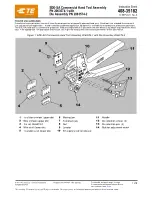
engine instrument window that replaces the L/R HP and L/R fuel flow
indications with L/R total fuel quantity readouts and a mismatch indicator.
Selecting a full window MAP display on DU #2 will force DU #3 to display
primary engine instruments on the upper 1/6 window and CAS on the lower
1/6 window (deselecting full MAP will revert DU #3 to previous settings).
Selecting a full window MAP display on DU #3 will force DU #2 to display
CAS on the lower 1/6 window (deselecting full MAP will revert DU #2 to
previous settings).
In the case of any of the following events, full window MAP is not available
and if displayed when the event occurs, full window MAP will revert to 2/3
window:
•
Single or multiple DU failure
•
A secondary engine parameter is exceeded
•
A checklist is automatically called up a CAS event
•
Selection of full window MAP on the adjacent DU #2 or DU #3
C. Cursor Control Devices (CCDs):
(See Figure 15.)
A cursor control device (CCD) is installed on each sidewall of the cockpit
for use by the pilot and copilot. The CCDs are ergonomically positioned as
armrests with an extension containing buttons and switches easily
manipulated by hand movements. The CCDs provide an interactive link
with the DUs to select and change items for display. Each CCD has the
following features:
•
Three display unit selection buttons - the pilot side can control DUs
#1, #2 and #3, copilot side can control DUs #2, #3 and #4
•
A movable cursor pointing device
•
A rotary dial to adjust ranges or values
•
An enter button to select the option designated with the cursor
•
A push to talk button for communications
The crew first selects the display on which the cursor will be active using
the selection buttons. The cursor then appears on the active display,
formatted as a green plus (+) type symbol for the pilot cursor or a blue (x)
type symbol for the copilot. The pilot cursor will appear in the upper right
corner of the 2/3 window on DU #2, and the copilot cursor will appear on
the upper right corner of the 2/3 window on DU #3. If DUs #1 or #4 are
selected, the respective cursors will appear on the outboard edge of the
Horizontal Situation Indicator (HSI). The cursor is moved within the
selected display with the pointing device on the CCD. As the cursor moves
across the display, interactive areas (selectable with CCD input) are
highlighted, with buttons and menus appearing with a blue background and
a white outline when beneath the cursor position. Pop up menus are
available on all windows except the PFD, primary engine display and the
CAS message windows. (The only items available for change on the PFD
are the range adjustment on the HSI and a choice of displayed information
- i.e. a particular navaid for an approach.)
A menu is selected with the enter button on the CCD. When a menu is
selected, the cursor is automatically positioned to the first item on the pull
OPERATING MANUAL
PRODUCTION AIRCRAFT SYSTEMS
2A-31-00
Page 38
July 15/04
Title Page
Prev Page
Next Page
TOC
















































